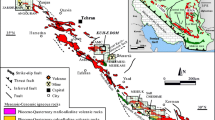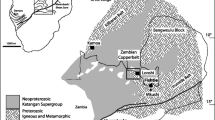Abstract
Mineralisation at the Zarshuran, NW Iran, occurs on the flank of an inlier of Precambrian rocks hosted in black silty calcareous and carbonaceous shale with interbedded dolomite and limestone varying in thickness from 5 to 60 m and extending along strike for approximately 5–6 km. Two major, steeply dipping sets of faults with distinct trends occur in the Zarshuran: (1) northwest (310–325) and (2) southwest (255–265). The main arsenic mineralisation occurs at the intersection of these faults. The mineral assemblage includes micron to angstrom-size gold, orpiment, realgar, stibnite, getchellite, cinnabar, thallium minerals, barite, Au-As-bearing pyrite, base metal sulphides and sulphosalts. Hydrothermal alteration features are developed in black shale and limestone around the mineralisation Types of alteration include: (1) decalcification, (2) silicification, (3) argillisation, (4) dolomitisation, (5) oxidation and acid leaching and (6) supergene alteration. The early stage of mineralisation involved removal of carbonates from the host rocks, followed by quartz precipitation. The main stage includes massive silicification associated with argillic alteration. In the late stage veining became more dominant and the main arsenic ore was deposited along fault cross cuts and gouge. These characteristics are typical of Carlin-type sediment-hosted disseminated gold deposits. The early stage of mineralisation contains only two-phase aqueous fluid inclusions. The main stage has two groups of three-phase CO2-bearing inclusions with minor CH4 ± N2, associated with high temperature, two-phase aqueous inclusions. During the late stage, fluids exhibit a wide range in composition, salinity and temperature, and CH4 becomes the dominant carbonic fluid with minor CO2 associated with a variety of two-phase aqueous fluid inclusions. The characteristics of fluids at the Zarshuran imply the presence of at least two separate fluids during mineralisation. The intersections of coexisting carbonic and aqueous inclusion isochores, together with stratigraphic and mineral stability evidence, indicate that mineralisation occurred at 945 ± 445 bar and 243 ± 59 °C, implying a depth for mineralisation of at least 3.8 ± 1.8 km (assuming a lithostatic pressure gradient). Fluid density fluctuations and the inferred depth of formation suggest that the mineralisation occurred at the transition between overpressured and normally pressured regimes. Geochronologic studies utilising K/Ar and Ar/Ar techniques on hydrothermal argillic alteration (whole rock and separated clay size fractions) and on volcanic rocks, indicates that mineralisation at Zarshuran formed at 14.2 ± 0.4 Ma, and was contemporaneous with nearby Miocene volcanic activity, 13.7 ± 2.9 Ma. It is proposed that mineralisation was the result of the infiltration of hydrothermal fluids containing a magmatic gas component, and that it was localised in the Zarshuran Unit because of the redox boundary that it provided and/or because it lay between an overpressured region at depth and a zone of circulating, hydrostatically pressured fluids above.
Similar content being viewed by others
Author information
Authors and Affiliations
Additional information
Received: 10 December 1997 / Accepted: 5 March 1999
Rights and permissions
About this article
Cite this article
Mehrabi, B., Yardley, B. & Cann, J. Sediment-hosted disseminated gold mineralisation at Zarshuran, NW Iran. Mineral. Deposita 34, 673–696 (1999). https://doi.org/10.1007/s001260050227
Published:
Issue Date:
DOI: https://doi.org/10.1007/s001260050227




